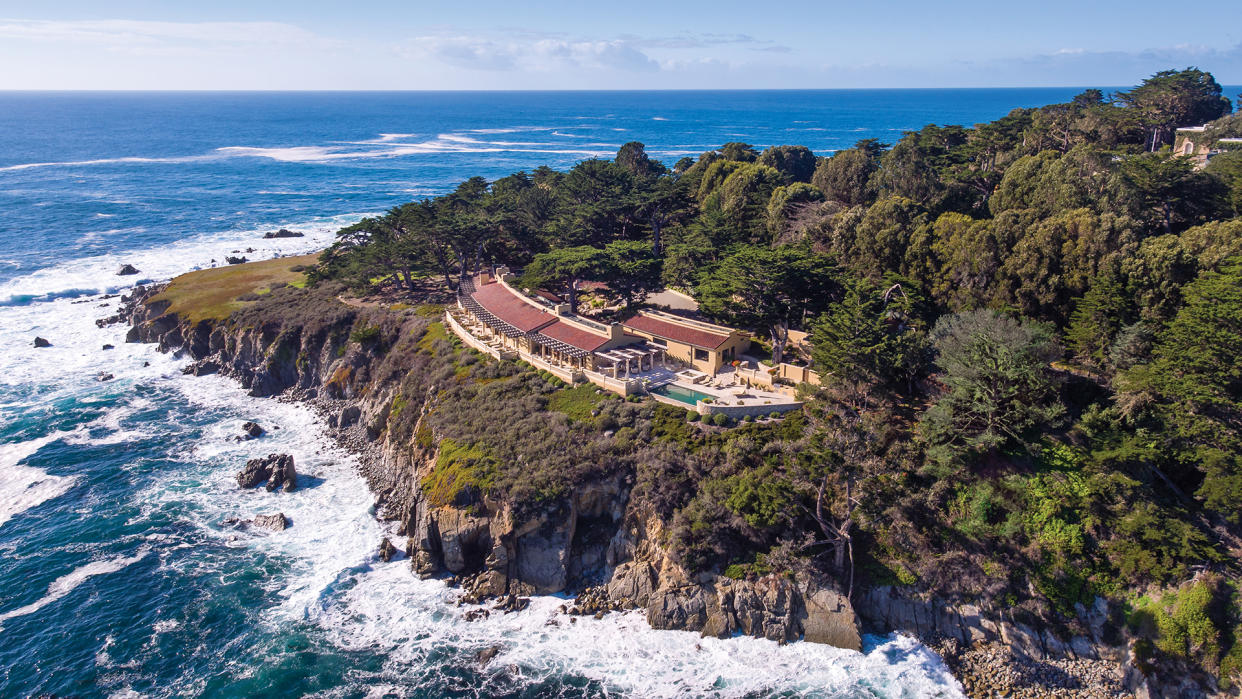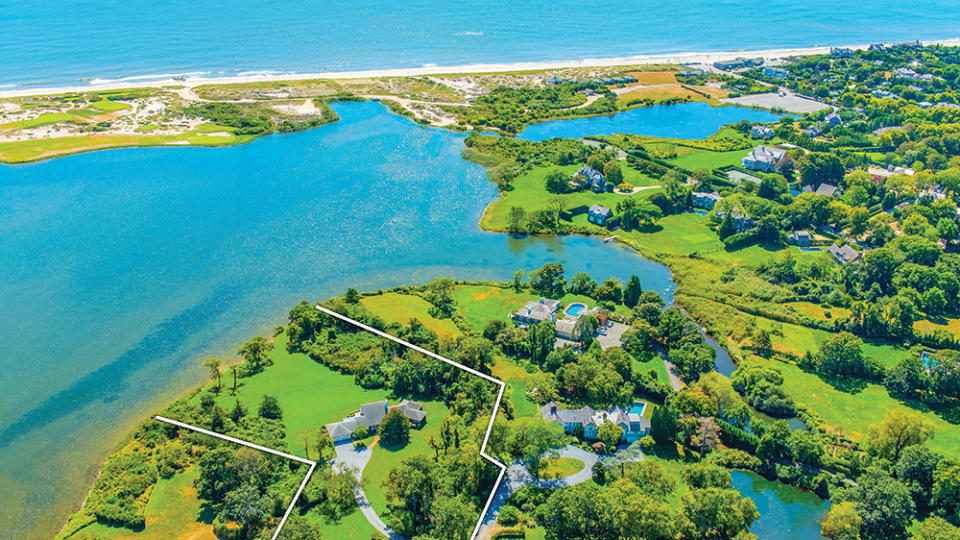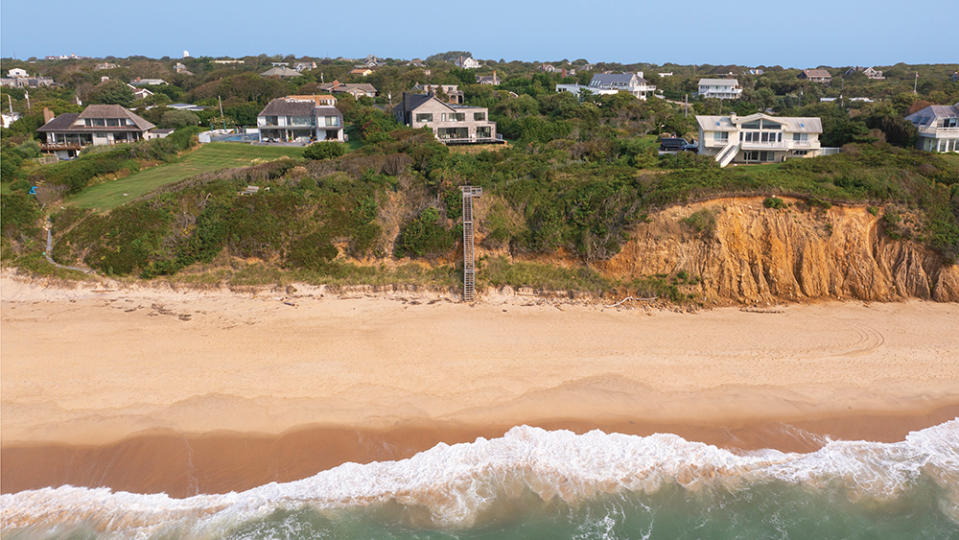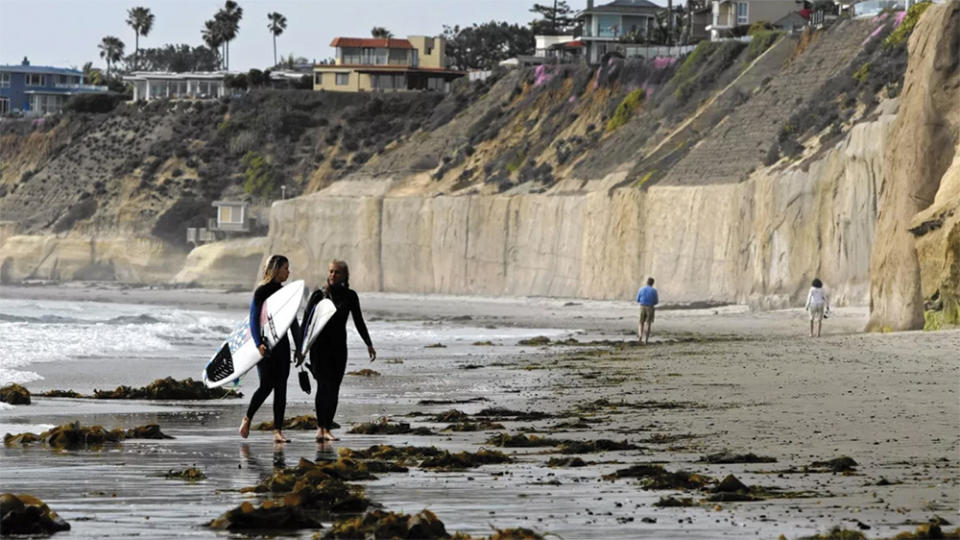Beach Houses Around the Country Are at Risk of Sinking, and Coastal Enclaves Are at War About How to Save Them

It was after a beachside housewarming party in Southern California that the neighborhood snitch was unmasked. Residents of the cliff-top community had gathered to eat lobster and indulge in a favorite local pastime: grumbling about coastal-protection rules that stop them from reinforcing the eroding bluffs beneath their homes under the theory that any hardening of the shore will exacerbate beach erosion.
“A new neighbor had moved in and done this beautiful remodeling job on a house that was in a huge state of disrepair,” recalls one guest and longtime resident. “And he had this incredible party [with] music playing, and everyone had the most wonderful afternoon. Later we found out that one neighbor turned him in to the city because he found out he’d built a home office,” which the tattletale suspected contravened the area’s strict environmental regulations.
More from Robb Report
The party guests were appalled when they saw the neighbor’s name on the official complaint. “We said, ‘OK, this Mr. Nosy Pants is in there, you know, having his lobster tail and his shrimp cocktail and meanwhile taking notes furiously,’ ” says the resident, who spoke on the condition of anonymity. Soon after, others in the community realized the same person was also ratting on them to the authorities for unpermitted home repairs.
“He ended up in litigation with several neighbors,” says the resident, who hired an attorney herself after receiving an inspection notice from the city during what she describes as a simple bathroom-retiling project. In a yet-to-be-resolved case, she’s suing the neighbor for harassment, trespassing and false claims. “This is how coastal homeowners live.”
If the drama has a weird whiff of Stasi tactics, such is the level of conflict in beachside communities over efforts to mitigate the effects of climate change on that ultimate prized possession: a waterfront home. Nothing is more aspirational right now, as is evident from exponential price growth along America’s most desirable shorelines. Yet nothing is more ephemeral. The increasing frequency and severity of storms and coastal erosion mean that seaside homes are, to varying degrees, inevitably doomed.
Just ask Jesus, who spoke of the “foolish man, which built his house upon the sand: And the rain descended, and the floods came, and the winds blew, and beat upon that house; and it fell: and great was the fall of it.” Something to bear in mind if you’re eyeing property on a barrier island.
It takes a certain confidence in one’s own luck to invest millions of dollars in a house erected on sand. Even those who can afford to write off any damages don’t relish the prospect of evacuation or the dangers to their families. So why do we keep buying waterfront homes? What are the real risks? And, for those determined to stick it out, what can you do to protect yourself?
The allure of coastal living is carved into the bedrock of our collective psyche. Seven of the current top 10 most expensive zip codes in the US are on the water, in California, Florida and New York. Price increases have been particularly precipitous in the past year, with third-quarter 2022 values up 37 percent over the previous year in Malibu and 23 percent in the Hamptons, where the market share of sales above $5 million was the highest on record, at 12.9 percent, according to reports by real estate agency Douglas Elliman.

As prices surge, so does the actual tide. Sea levels along the US coastline are expected to be, on average, 10 to 12 inches higher by 2050, according to the National Ocean Service, resulting in a tenfold annual increase in “damaging” flooding. Children alive today may live to see global sea levels climb by as much as eight feet by 2100, according to the National Climate Assessment. By that time, it’s likely that US real estate currently worth $238 billion to $507 billion will be below sea level.
“The sea rise for the next 30 years is already committed,” says Don Bain, a senior adviser at Climate Central, a climate science organization. “We have a choice about how fast it rises after that, but we don’t have a choice about it rising.”
In the past few years, the flood risk for individual homes was added to popular real estate websites Realtor.com and Redfin.com by First Street Foundation, a climate nonprofit. The data gives people “a property-by-property understanding of how their risk stands today, but also how that’s going to change over the course of the US standard 30-year mortgage,” says Mike Lopes, a former spokesman for the foundation. The hope is that warnings such as, “This property has a 100 percent risk of flooding over 30 years,” will give coastal buyers pause.
But at the top end of the market, the risk of submersion hasn’t dampened spirits, nor does a vibe shift seem imminent. As the highest levels of wealth have swelled and ties to the office have loosened, so beach houses—a finite resource—have become more desirable. This imbalance of supply and demand may well shore up coastal pricing for years to come.
“You know, the expression is, ‘They just don’t make this stuff anymore,’ ” says Fred Stelle, an architect known for designing contemporary beach houses for well-heeled Hamptons residents, including Calvin Klein. He believes storms and floods alone won’t stop price hikes, though he does anticipate that residents will have to absorb sharply rising costs, including insurance, damage mitigation and taxation.
Many coastal homeowners can afford to increase the gradient of their land, elevate their house or build a seawall. But these solutions are subject to local building codes, which vary sharply. Seawalls, for example, are now mandatory in Miami but prohibited along much of the West Coast.
In the Hamptons, requirements differ between villages and enforcement is patchy. “There’s an exception to every rule,” says Alison Branco, the New York director of climate adaptation for the Nature Conservancy, a global environmental non-profit. Seawalls “that pre-exist the newer rules are allowed to be rebuilt. After Superstorm Sandy, a lot of folks were given temporary permits for things that became permanent.”
Seawalls are controversial because they prevent the natural dissipation of wave energy along a beach. Instead, waves rebound off a hard barrier, bouncing the energy back onto the beach and stripping away sand or simply passing the buck down the shore. Branco likens the Long Island coastline to an arms race.
“If one person has a seawall, then that enhances erosion on the property next to them,” she says. “And then the next person kind of has to be allowed to have one to protect themselves, and then it just marches right down the shoreline.”
The issue of erosion is so contentious that it has become awash with euphemisms: Importing sand is “beach nourishment,” “sacrificial sand” or “sand infusion.” Giant sandbags are “geo-tubes,” concrete seawalls “shoreline armoring.” Abandoning the coast? “Managed retreat.”
Litigation abounds. “Typically, cases are settled out of court, which is why it doesn’t often make it to the point of a legal precedent,” explains Branco, who says that town committees, usually made up of volunteers, tend to wilt in the face of lavishly lawyered property owners. “People are used to getting their way.”
Even softer solutions have become a granular issue. For some years now, the Army Corps of Engineers has been replenishing the beach in Montauk, where residents are fastidious about sand. “Even if they got the grain size to the right specification,” says Branco, “it’s kind of a different color brown than the sand that’s usually there, and that really bothered people.”
The town of East Hampton, which encompasses the village of Montauk, is now boldly attempting to persuade the local community to sign on to a resiliency plan involving multiple buyouts and the evacuation of much of downtown Montauk, which is sandwiched between the beach and a pond. Shannan North, a broker for Brown Harris Stevens in the Hamptons, isn’t convinced. “My grandma, who’s 96, worked [as a cleaner] for many of these big estates on the ocean,” North says. “Back in the ’40s, after the Depression, they used to take old cars and Christmas trees and bury them out in the ocean,” to deter erosion. The point being that the issue is a perennial one, and most homeowners are protected by their wealth.
Meanwhile, residents are busy elevating their houses, and Stelle is the man they call. “About 20 years ago, we did a house here on the coast,” he recalls. “They loved being on top of the dune,” he says, and ignored the architect’s advice to move to more stable land set back from the beach. “So we designed a house where the ground floor was kind of expendable. About five years ago, we had a storm that did wash through the house and flooded the ground floor with about five feet of sand. And they literally swept up the sand and that was it.”

Home elevation makes sense, argues Climate Central’s Bain, only if roads and other utilities are also raised. “Your property may be on pilings up in the air, but if you can’t travel to it, then it’s hard for that to be a viable solution,” he says.
Sometimes areas simply become unlivable. In Charleston, S.C., one New York City transplant, Suzanne Fine, built her dream family beach house, only to move out of it within three years. Before they commissioned the Isle of Palms house, Fine and her husband had been assured by a state beach-conservation senior official that the sand on the barrier island near Fort Sumter was not at severe risk of erosion. The couple took precautions by elevating the house and following local building codes to the letter. “You have to have a certain number of piles and porous acreage on your lot,” says Fine, as well as “graded windows, lots of good insulation and proper roofing that can withstand hurricane-force winds.”
When the couple and their three children moved in, in 2014, the public beach in front of their home had three dunes, Fine recalls. “We got down to half a dune within one year.” Hurricanes forced them to evacuate two to three times per year, and their boardwalk repeatedly washed away.
Neighbors swapped tips. “Some of them paid to bring in sand, some planted more dune grass,” Fine says.
“One neighbor directly next to me, one storm basically pulled all the dunes away, right up into her pool.” She and her husband began to worry about the long-term value of their house. “I know everyone likes the beach, but what’s going to happen if, all of a sudden, your fire pit is in the ocean?”
Despite the shifting sands, they had no trouble finding a buyer, who, according to Fine, “bought a house downtown at the same time” to determine her preferred location; the woman unloaded the beach house within a year. Fine now feels safer in her home in central Charleston but is by no means free from the effects of extreme weather: “You know, we feel as confident as one can feel in a city that is constantly being flooded and affected by storm surge.”
In a pattern repeated along the US’s coastlines, prices on Isle of Palms shot up during the height of the pandemic. Fine thinks she could have sold the house for 30 percent more if she’d listed it the first year of Covid. “There’s so much building going on at the beach,” she says. “Every other house is under construction.”
The Florida coast is also seeing a building boom, though local governments in the Sunshine State treat flooding as an antagonist to be subdued with concrete. In a state with no income tax, property taxes are all-important, and towns have a strong vested interest in maintaining high waterfront-home values.
“Listen, if people were genuinely deathly afraid of sea-level rise, they wouldn’t be buying” in Miami, says James Curnin, CEO of Clara Homes, a developer specializing in luxury waterfront spec houses. His buyers represent the new wave of Florida arrivals: not the retired snowbirds of yesteryear but singles and couples in their 30s and 40s. “Real estate and finance guys from New York and the VC and tech world coming from California.”
Of these, he says, “very few are nervous about sea-level rise,” and any ripples of anxiety are rebuffed by a fortress of shoreline armament. Miami Beach, which already has approximately 53 miles of seawall, nearly all of which is privately owned, “won’t issue new building permits without a new seawall,” says Curnin, who also elevates his “concrete bunker” homes to 10 or 11 feet above sea level. “You never want to be the lowest house,” he says. “If the neighbor to the right or to the left of me is a lower home, they’re going to flood first.”
One reason Florida’s barrier islands have embraced the seawall is that the islands were largely built on reclaimed land and therefore artificially fortified from the beginning. Todd Michael Glaser, a Palm Beach developer with properties ranging from $24 million to $218 million, grew up in Miami Beach and recalls fishing off the docks. Since then, he says, “I’ve seen it increase at least four to five inches.”
Still, he’s unconcerned and says his Palm Beach clients share his insouciance. “Look, in 30 years I’ll be 88 years old—am I even going to be living?” he asks. “Palm Beach is a little older… so it’s not on their radar.” The pandemic overlaid the natural nonchalance of Floridians with a carpe diem mentality, says Glaser, who recently became known for flipping Jeffrey Epstein’s Palm Beach estate. “Appreciation of life and appreciation of wealth have taken over the embarrassment of spending your money,” he says, adding that the old-school approach to affluence—“don’t talk about money, don’t show your money, be modest”—has given way to ostentation.
On the Gulf Coast, in low-lying Naples, the tone is similarly confident, despite predicted rises in sea levels of 10 to 40 inches by 2050. Real estate price spikes are “really exponential,” says John Covelli, a local high-end developer. A plot of land bought for $1 million would, he says, normally sell for $5 million after building a house. Now such homes “are probably worth $10 million to $12 million.”
Covelli considers this trajectory to be unsustainable, but, as in Miami, the market is flooded with escapees from cities. A few buyers have shown a tendency to avoid the coastline, but most are unconcerned, he says, adding that there are differing local opinions about the seriousness of climate change.
Californians are anything but relaxed about the subject, yet coastal homeowners in the south of the state are increasingly torn between protecting the environment and protecting their homes. Artificial shoreline hardening, including seawalls, has been discouraged since 1976, when the California Coastal Act was created to safeguard the state’s 1,200-mile-long shoreline and guarantee public beach access. (When bluffs are armored, beaches disappear; collapsed bluffs, on the other hand, replenish beaches.) The policy has left coastal dwellers with few good options when it comes to stabilizing the fast-eroding bluffs in their backyards.
If homeowners have pre-1976 seawalls, repairs require permits from the California Coastal Commission. “Those permits are not easy to come by, to say the least,” says Sheila Etheridge, a Realtor with the Agency brokerage in San Diego. “Here, there are seawall court battles left and right.”
The anonymous SoCal resident with the nosy neighbor bought a bluff home 20 years ago. “We had a grandfathered-in partial seawall from the ’60s and probably one of the nicest sets of beach stairs along our street,” she says. “The problem was, you used to be allowed to do repairs within the existing footprint, but you can’t even do that anymore. You can’t touch your bluff.”
Requests for stair repairs can be viewed suspiciously as fronts for shore hardening. Permits for alterations to bluff-top houses themselves are often granted only on condition that homeowners comply with the latest setback requirements—meaning they’d have to move all structures behind the most recently approved boundary.
Local homeowners feel that the commission’s moratorium on bluff reinforcement is dangerous, the former resident maintains, citing the 2019 deaths of three women who were killed in front of their children by falling sandstone on Grandview Beach, in Encinitas. The widowers and children of the victims, who were all members of the same family, are suing the state, the city and the condominium complex atop the bluff.
As elsewhere, the local says, the area is a magnet for wealthy city families “attracted to the coastal lifestyle. We call them hippie yuppies.” She sold her home last year before it even hit the market: “They walk in the door and they fall in love with the incredible beauty that is the California coastline.”

Most agents and developers agree that a waterfront view trumps almost every other factor. “Clients do care” about the risks, “but the draw of living in a beautiful environment is hard to resist,” says Paul McClean, an architect of super-luxury coastal homes in California. “In the end, it will just mean spending a lot more money, but being oceanfront is such a scarce resource that someone will always be willing to build.” McClean must navigate the constantly shifting local codes. One of his current projects, on a large lot, was able to secure a permit to build at a depth of only “roughly a third of the neighboring properties due to consistent erosion.”
The issue is sufficiently urgent that a bill was recently introduced proposing that California buy out vulnerable homes from owners ready to retreat, then recoup the cost by renting them out until they became unviable. Governor Gavin Newsom vetoed the bill in October, but only because it was not adequately funded.
In the meantime, buyers of coastal properties now struggle to purchase insurance. “They say, ‘Oh, we’re self-insuring,’ ” says Tim Allen, a broker with Coldwell Banker on California’s Monterey Peninsula. “Well, that’s a nice way of saying they’re not getting insurance because they can’t.”
The reason, he says, is the huge payouts insurers have had to make to victims of wildfires: “They don’t want to insure here because it’s too big a risk… How long can it go on, that insurance can’t happen in California? I get it back east—people there are building in places where every 15 to 20 years there’s a hurricane and it wipes everything out. I mean, that’s kind of stupid.”
Christopher McDonald, a principal broker at Amaden Gay Insurance, an eminent Hamptons agency, confirms Allen’s assessment of the industry. “We’re seeing a dramatic change lately because the severity and frequency of natural disasters has really been noticeable,” he says. But he adds that when carriers pull out of an area, “other carriers see that area as an opportunity. When you have a year where natural-disaster activity is quiet, the insurance industry tends to forget about it, and carriers start going back. So it kind of goes in cycles.”
With even insurance companies taking a short-term view, many local governments are similarly stuck in a cycle of permitting rebuilding in vulnerable places in order to maintain their property-tax revenues. Such “perverse incentives” will persist, says Lopes, formerly of First Street Foundation, until the cost of reconstruction becomes more expensive than relocating. Until then, many towns prefer to bury their head in the sand.
The biggest perverse incentive might be communities holding out for a major disaster. “That’s when very large sums of [federal] money become available,” says the Nature Conservancy’s Branco. She advises endangered towns to plan for managed retreat, “so that when the next hurricane comes, they’re ready to access those larger sums of money to do a lot of buyouts.”
Meanwhile, coastal homeowners bequeath the problem to their children and grandchildren, a cursed inheritance. “But the point is that it’s happening right now,” Lopes says. “It’s happening today.” Under the elevated homes, the sands are sinking.
Best of Robb Report
Sign up for Robb Report's Newsletter. For the latest news, follow us on Facebook, Twitter, and Instagram.

